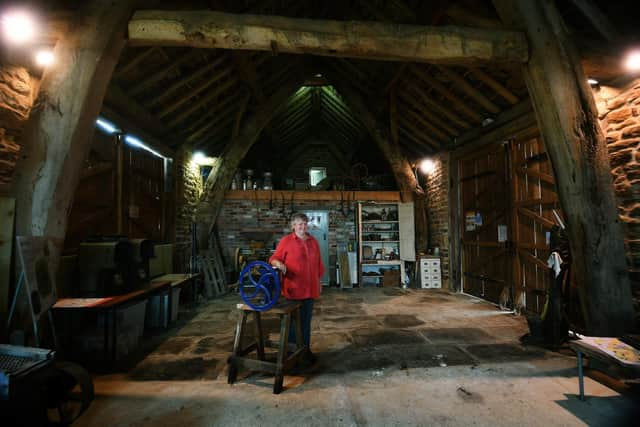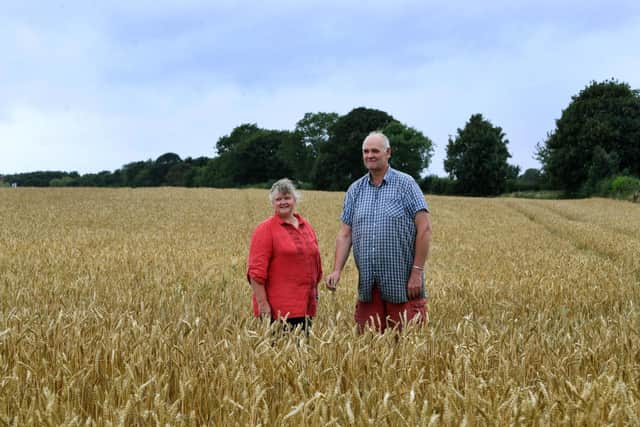Farm of the Week: Grandfather and 100 cows who travelled on the train together from Scotland to Barnsley
Helen and David are the third generation to farm at New Hall Farm which runs to 800 acres between the old pit villages of Ardsley and Darfield where David’s grandfather William Miller came to from Dumfries, bringing his 100 Ayrshire cows with him on the train in 1953 and unloading them at a bridge nearby.
Helen said that dairy cows were still a large part of the farm until 2005 when David’s brother Douglas set up his new dairy herd in Warwickshire and that since then New Hall has been almost wholly arable.
Advertisement
Hide AdAdvertisement
Hide Ad“We have something like 90 separate land parcels with our smallest being four acres. Our largest field is 44 acres but that is only because we bought the land off someone who had ripped out the hedges.


“Arable-y speaking, the sensible thing for us to do would be to rip out all of our hedges to create larger fields to grow more and make farming more cost effective, but that goes against what we are trying to do environmentally, and we are quite passionate about that.
“We have always done countryside stewardship since it first started in 1994. We were one of the first signatories and prior to that we had been involved with the Hedgerow Incentive Scheme and a lot of schemes with the local council.”
Having a lot of small fields is problematic for Helen and David in a number of ways, not least being the effect on productivity with so many more edges, corners, headlands courtesy of smaller fields and hence greater compaction, but Helen also believes that those arable farms with a greater wildlife habitat should be considered differently for the density of wildlife population they are enhancing.


Advertisement
Hide AdAdvertisement
Hide AdHelen said she is trying her best to get the message across about their farm and others like theirs that are farming on what is now called peri-urban land, previously known as urban fringe farmland, and others that just have lots of smaller fields.
“I’m trying to jump up and down, speaking to everyone I can, to get the message out that environmental and stewardship farming operations such as ours need to be looked at in terms of scale.
“All of the schemes need to be looking at the density of habitat. Our density of wildlife habitat and habitat creation is much greater than someone with a 300-acre field. It therefore costs more to farm that area and yet we are only getting the same figure per kilometre of hedge even though we are also providing more species-rich and greater environmental gain. I’d like to see more balance in the stewardship scale."
Helen said that their 700 acres of arable land, of the farm’s 800 acres, performs well and that they are moving towards the regenerative approach.
Advertisement
Hide AdAdvertisement
Hide Ad“Our land is fairly kind land with loam to a sandy loam. We get excited if we get anywhere near four tonnes per acre with our winter wheat, but generally average around 3.5 tonnes.
“We are working more towards the regenerative way of working the land, which will probably lead to a bit of a hit on yield while we adapt but it only makes sense to look after the thing that you’re totally dependent on and emotionally regenerative farming allied with the environmental stuff we are doing appeals.
“But part of you thinks we’ve still to produce food and we’ve still a bottom line to attain. The positive side of regenerative is one pass instead of three, which brings down compaction.”
Caroline, who has joined her parents since completing her studies at Harper Adams, said this year’s harvest is under way.
Advertisement
Hide AdAdvertisement
Hide Ad“We have around 195 acres of winter wheat variety Skyfall, which we grow on contract for Warburtons; 167 acres of winter barley varieties including Kingsbarn, Kingston and Tardis grown for feed; 47 acres of spring milling wheat and the rest of our crops are made up of winter and spring beans and cover crops that include mustards, radish, vetch and black oats.
“Our rotation varies but is largely first or second wheats followed by barley, then barley or beans or spring wheat. We put in the cover crops before the spring crops.”
Helen is on the CLA’s national environment committee and is looking to fly the flag for issues emanating from farming in a peri-urban area, and she is also looking at how New Hall can diversify to create greater income in the future.
“We have a wonderful 16th century cruck barn that has been restored and we already do something with it, but we could do more.
Advertisement
Hide AdAdvertisement
Hide Ad“I’m interested in pursuing the care farming side of things. We have been involved with education through school visits since David’s mum Margaret started with them in the 1970s and the visits today come under our stewardship arrangements.
“Recently we had a farm visit where I was told a young lad had been in school for three months without saying a word and coming here was the first time his teacher had heard him speak.
"It’s about being in an environment that absorbs the senses and involuntarily children find themselves asking questions or in awe of the surroundings. I’d like to explore that more."
David manages the day-to-day work on the farm and all of the cropping, Helen looks after the stewardship and office work and Caroline is currently part time.
Advertisement
Hide AdAdvertisement
Hide AdCaroline said her initial thoughts for the farm’s future are to take it back towards a mixed farm.
"I’d maybe see us with sheep and beef cattle. We are trying a few breeds of sheep with a small flock of 23 breeding ewes including Suffolk-cross, Ryeland-cross and Derbyshire Gritstone all put to a Suffolk ram.”
